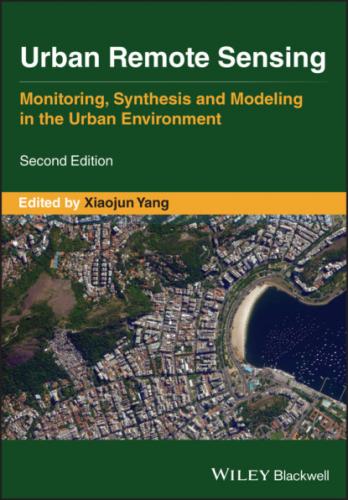Although there is a variety of UAS‐oriented photogrammetric software packages available, they can generate several common outputs, such as 3D point clouds, orthophoto maps, DEMs (surface and/or terrain), and 3D textured models. Fortunately, photogrammetric software packages utilize relatively common conceptual workflows, although their specific terms/steps may vary. By utilizing SfM and MVS algorithms, photogrammetric software packages can automatically extract 3D features from the UAS images by finding common feature points between overlapping images (Lowe, 2004). According to Remondino et al. (2011), a typical UAS photogrammetry workflow includes the following: mission planning, ground control measurements (if needed), image acquisition, camera calibration, image orientation, and image processing to generate 3D data.
3.4 UAS FOR URBAN APPLICATIONS
The unique ability of UAS to collect data at user‐defined spectral, spatial, and temporal resolutions offers new possibilities for urban applications that require rapid mapping, assessment, or management. Noor et al. (2018) summarized several types of information that can be provided by UAS for urban studies, including urban location and extent, land cover and land use information, transportation networks and infrastructure, census‐related statistics, and land change information. Despite that the use of UAS in urban areas is currently limited by regulations and safety concerns, numerous attempts have been made to explore the potential of UAS to support urban studies. This section discusses four common types of urban applications using UAS, including disaster response, infrastructure inspection, hyper‐local ecological information collection, and the construction of smart cities.
3.4.1 DISASTER RELIEF EFFORTS
Remotely sensed imagery provides invaluable information for rescue and relief efforts, damage assessment, and the planning of remedial measures (Hussain et al., 2011). With UAS, disaster zones can be observed and assisted promptly. Aljehani and Inoue (2019) designed a system that incorporates UAS scanning and UAS tracking to generate a safe map with potential routes for refugee evacuation. They have successfully utilized UAS to detect and track pedestrians by the Haar‐cascade and Kalman filter classification method, which can serve as a substitute for participatory tracking (e.g. mobile tracking) when pedestrians are not carrying mobile devices. Practically, they proposed using mobile networks for communication when the standard communication channels are completely lost. They also stressed the importance of human operators in the evaluation process and mission management (Aljehani and Inoue, 2019).
After a disaster, accurate and swift searching for the affected population and understanding their needs (e.g. water, food, medical assistance, etc.) is urgent and challenging. With the aid of UAS, humanitarian relief can be more efficiently delivered. Bravo et al. (2019) developed a Partially Observable Markov Decision Process (POMDP) to improve UAS path planning by giving higher priorities to the areas that are more likely to have victims. They showed that the method can provide the full coverage of the affected area and optimize the time to find the victims groups in three different cases, namely a tornado in Xanxerê, Brazil, a refugee camp in South Sudan, and a nuclear accident in Fukushima, Japan, which only took no more than 10 minutes, 5 minutes, and 2 hours, respectively (Bravo et al., 2019). However, they also mentioned that the use of UAS can be limited by the location, sight, limited base distance, battery life, and the concerns of social acceptance and airspace access.
3.4.2 BUILDING INSPECTION
The built environments we live in are constantly aging and wearing down. Regular checking of rooftops is critical to identify wet insulation issues at an early stage and prolong the lifespan of building roofs. Heat transfer and air loss through windows, cracks, chimneys are important causes of energy loss in residential buildings. Therefore, infrastructure inspection is necessary to maintain their energy efficiency and reduce further maintenance costs. UAS can capture thermal patterns with infrared cameras and generate 3D Computer‐aided Design (CAD) models, which can help to assess energy production and conservation of urban structures (Rakha and Gorodetsky, 2018). Some efforts have been made to advance UAS applications in building inspections. For example, Zhang et al. (2015) developed a relative thermographic calibration algorithm and automatic thermal anomaly detection methods. Besada et al. (2018) demonstrated an automated flight process achieved with a Mission Definition System for infrastructure inspections using UAS. However, there are still some issues concerning the UAS applications in building energy audits. For example, better GPS accuracy is needed. The accuracy of UAS and its ability to avoid obstacles relies heavily on the accuracy of the onboard GPS and Inertial Navigation System (INS) (Steffen and Förstner, 2008). There are no conclusive strategies for path planning or inspection distance optimization for the UAS‐based building audit, which points toward a new research direction (Rakha and Gorodetsky, 2018).
3.4.3 PHYSICAL DISORDER DETECTION
The physical characteristics of neighborhoods are important information for analyzing the effects of place on social problems. However, this information is usually unavailable or measured with aggregated secondary data that are only suitable for large‐scale investigations. Grubesic et al. (2018) used UAS to evaluate hyper‐local information on physical disorders like litter, unkempt lots, and building decay. They conducted two low‐altitude missions with an Ebee, a fix‐wing model from senseFly, at 65 m flying height, 60% lateral overlap, and 75% longitudinal overlap to survey two neighborhoods in Phoenix, Arizona. In each neighborhood, a total of 91.96 and 45.18 acres were covered with 382 and 217 RGB images, respectively. The resulting UAS imagery is much sharper than common medium‐resolution satellite imagery and makes it easier to discern small objects like air‐conditioning units. Compared to omnidirectional street imagery, UAS imagery is not influenced by temporal mismatches or blocked sight caused by depth perspective. The UAS approach also turned out to be more economical than the traditional way to collect hyper‐local data through systematic social observation (SSO) or neighborhood audits.
3.4.4 SMART CITIES
Smart city is an idea to integrate technologies to support a healthy, safe, and convenient way of urban living. In the realization of smart cities, UAS can play a role in monitoring, detecting, and predicting anomalies in urban environments
